
The Desert
June 2014
When we tell people that we are full-time RVers and that we travel most of the time, they will generally ask us what part of the country we like best. My answer is always that I like the desert country best. When they inevitably ask why that is, I run into a problem trying to explain my reasons in words. I thought I would try to explain in pictures. I am not sure that there is any photographer talented enough to effectively portray what the desert actually looks like. I know that I am not but I will offer what I have.

I do not believe there is any scenery in the world that is as spectacular as the Grand Canyon. This is a scene from the South Rim of the Grand Canyon. I chose this picture from about 50 that I have taken. Each picture shows a scene that is fantastic and unbelievable but not near as fantastic and unbelievable as the scene you will see as you stand on the South Rim where these pictures were taken.
When you approach the South Rim along the highway, you you can see nothing of the canyon until you get almost to the rim. Try to imagine the reaction and the language of some pioneer in a wagon who suddenly finds himself looking over the South Rim and realizing that he is totally SOL. His journey has just increased by hundreds of miles.
| This is the view from Dead Horse Point State Park in Utah near Moab.
There are two national parks, Arches and Canyonlands, also nearby with
equally spectacular scenery. This whole area around Four Corners
(where Arizona, New Mexico, Utah, and Colorado meet at a point) is often
referred to as "redrock country".
The name, Dead Horse Point, comes from a story about wild horse hunters who used the point to capture and train horses. They would drive the horses onto the point through a narrow access and then close that access with a fence. They could then pick out the best of the horses and train them enough to drive them to market. Apparently they forgot to leave the fence open and the horses left behind died. |
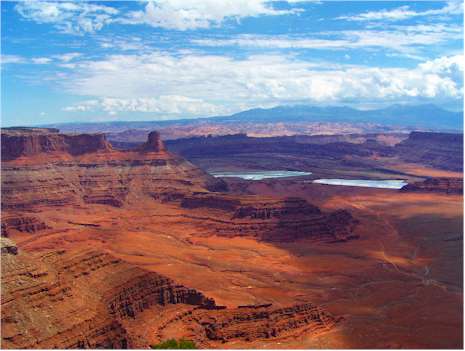 |
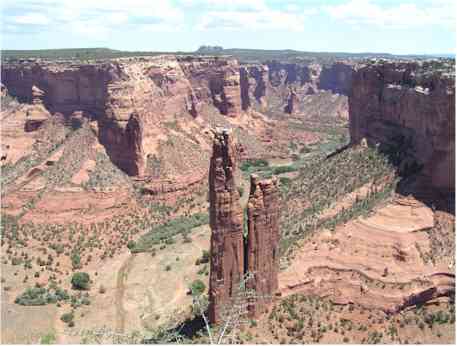
This is Canyon De Chelly (pronounced de shay) located in northeastern Arizona within the Navajo Nation. There are Anasazi ruins in the canyon similar to those seen elsewhere in the area. People still live in the canyon on farms and ranches and have lived there continuously since about 800 AD. No doubt property values are somewhat higher now.
| This is Monument Valley. It lies in Utah just north of the
Arizona border and near Four Corners. Most of the valley lies
within the Navajo Nation. If you have ever seen an old western
movie, you have most likely seen Monument Valley and, probably, one of
those two buttes. I don't usually like tours but in this case it is the only way into the valley. It turned out to be a lot of fun. The Navajo tour guide was very knowledgeable of the area geography, geology, history and mythology. However, both he and I failed miserably in trying to explain why a butte was called "Dinosaur Rock" to an Italian tourist that spoke very little English and no Spanish, French, or Navajo. |
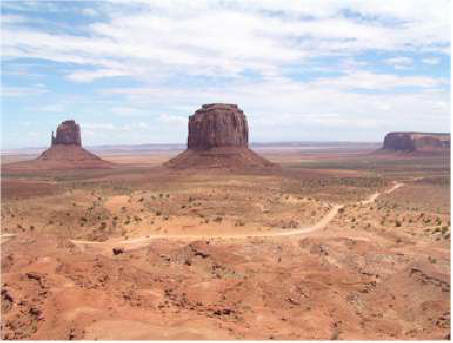 |
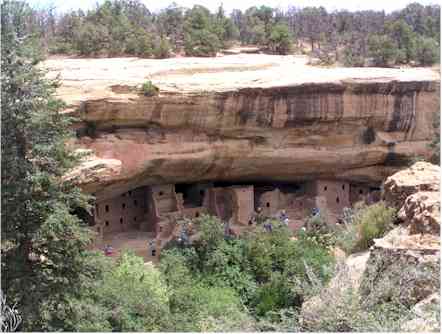
This is a canyon in Mesa Verde in Colorado. You can see the remains of an Anasazi town built into the canyon wall. We know very little about the people who built this town. They lived in this area in large numbers from about 800 AD until they rather abruptly disappeared about 1200 AD. The Pueblo tribes claim that they are ancient Pueblo people. The Hopi and Navajo gave them the name Anasazi which translates roughly as "the ones who came before".
| The Loretto Chapel was built in Santa Fe in 1878. When it was completed it was realized that there was no way to get to the choir loft, 22 feet above the chapel floor. Carpenters were called in but no one could come up with anything other than a ladder. Any staircase they could think of would take up too much floor space from the small chapel. Legends say that the nuns, who didn't want to climb a ladder to the loft, prayed for nine days to Saint Joseph, the patron saint of carpenters. On the ninth day, an old man with a burro to carry his tools showed up looking for work. He was hired and when the spiral staircase was finished, he packed up his burro and left. He never asked for any pay or even told anyone his name. The nuns believed that the old man was Saint Joseph. The mystery deepens even more. The design of the staircase is very unusual. It is entirely self-supporting. It is said that it has no nails, only wooden pegs were used in its construction. There also seems to be some mystery as to the types of wood and other materials used in the construction. |
 |
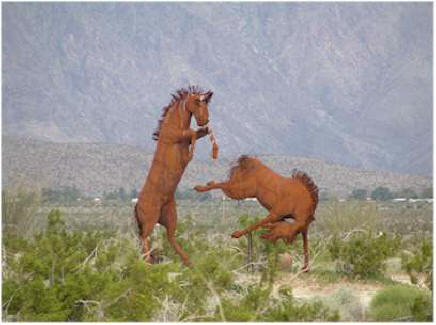
If you are traveling in the Borrego Valley near Borrego Springs, Ca., you might see two stallions fighting for leadership of the herd or perhaps you might see Columbian mammoth or even a dragon. Relax, you have not entered the Twilight Zone. You are seeing the artwork of Ricardo Breceda. There are roughly 130 such pieces of artwork to be seen in the area. The word "roughly" is used because every time he says this is the last one, another one appears. This is truly a work in progress. The sculptures are life-sized and so realistic that the first one I saw, I thought there really were two stallions fighting just 100 yards off the highway. The sculptures are spread out along the Borrego Springs Road north and south of town.
| As you may have heard, a alien spacecraft crashed outside of Roswell, NM in 1947. The story is plainly told in the UFO Museum in Roswell. However, there is a different story told by the Federal Government. They claim it was not an alien spacecraft but instead was a, you guessed it, weather balloon. A government conspiracy was claimed then and is often claimed today. The claim may or may not be true but keep this in mind. The is an old proverb in the aerospace industry. Never attribute to conspiracy that which can be adequately explained by stupidity. |
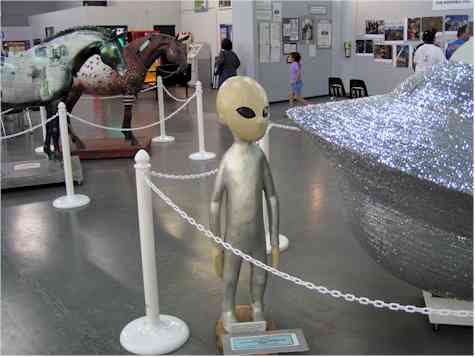 |
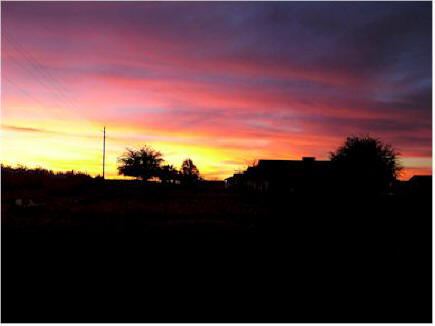
Even when your exciting day is over, the desert has one more gift for you.
For every photograph you see here there a thousand other such scenes somewhere in the American deserts. Well, maybe not the UFO Museum.